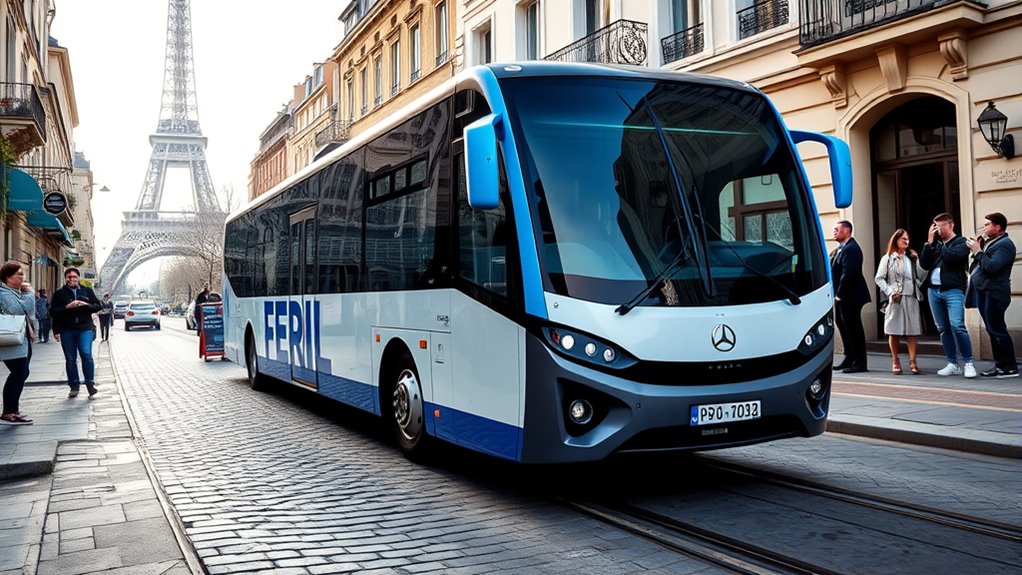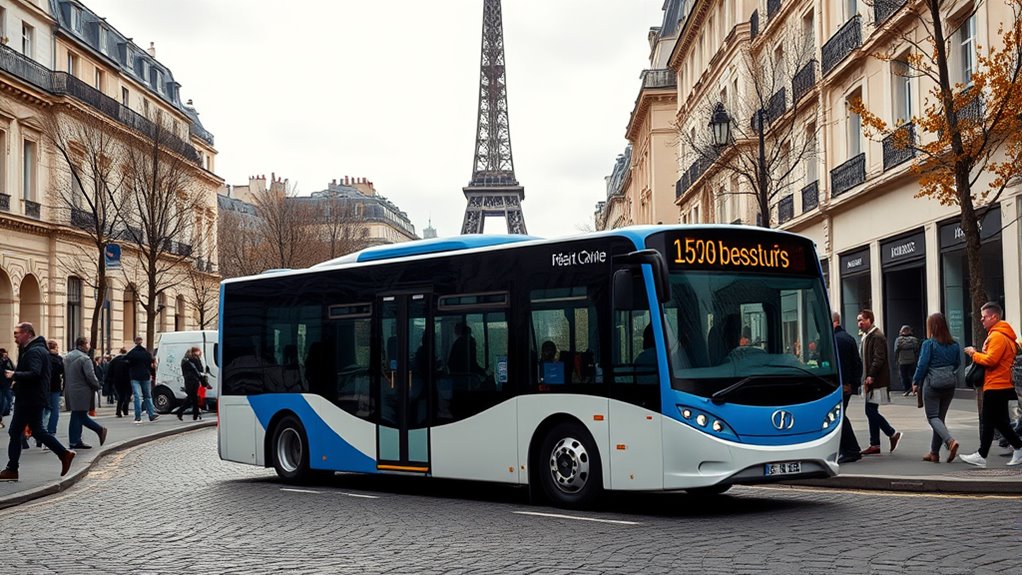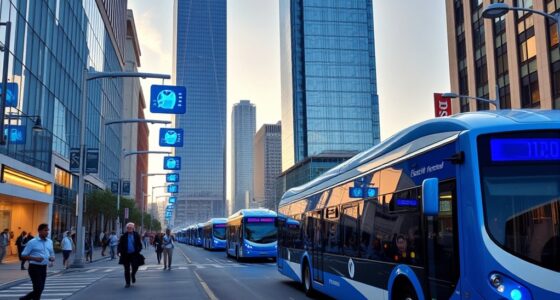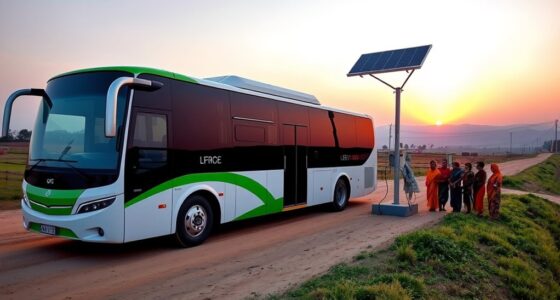Electric buses are transforming tourist destinations like Paris by cutting emissions, reducing noise, and improving air quality. You’ll notice quieter rides that let you enjoy city sights and historic districts more comfortably. Paris’s focus on electric public transportation shows how cleaner, greener transit elevates your experience while supporting sustainability goals. If you want to discover how these eco-friendly buses are shaping tourism and city life, there’s more to explore ahead.
Key Takeaways
- Electric buses enhance tourist experiences by reducing noise and pollution at iconic Paris landmarks like Champs-Élysées.
- Paris’s investment in electric buses aligns with broader European trends toward zero-emission public transport.
- Adoption of electric buses improves air quality and creates a cleaner, more sustainable urban environment for visitors.
- Challenges include high upfront costs and infrastructure needs, but technological advances and subsidies support expansion.
- Electric buses reflect Paris’s commitment to eco-friendly tourism, boosting its image as an innovative, environmentally conscious destination.

Electric buses are transforming tourist destinations around the world by offering a cleaner, quieter, and more sustainable way to explore these areas. In Paris, this shift is particularly noticeable as the city invests heavily in electric public transportation to enhance the visitor experience while reducing pollution. The move aligns with global trends, where government policies and environmental concerns drive the adoption of zero-emission buses.
Electric buses are transforming tourist destinations worldwide by providing cleaner, quieter, and more sustainable exploration options.
Paris, along with other European cities, is leading the charge, with a growing fleet of electric buses that help lower greenhouse gas emissions and improve air quality—critical factors for a city famed for its beauty and history.
The European market for zero-emission city buses is expanding rapidly, with a 53% increase in registrations in 2023. Countries like the Netherlands, Finland, and Iceland have achieved remarkable milestones, with 100% of new city buses being electric in 2024. Spain and the UK are also making significant progress, with over half of new buses being zero-emission.
France is part of this momentum, although it still lags behind with about a third of new buses being electric or hydrogen-powered. Still, the country is making strides, and Paris is at the forefront, continuously upgrading its fleet to be more eco-friendly. These developments reflect a broader push across Europe to meet sustainability goals, which benefits tourists by creating cleaner, quieter urban environments.
One of the biggest advantages of electric buses for tourists is the environmental benefit. These buses cut down on pollution, noticeably improving air quality in busy tourist hotspots like the Champs-Élysées or near major landmarks. Visitors often notice the reduction in diesel fumes, which enhances their overall experience. Increasingly, electric vehicle adoption is seen as a key element of sustainable urban planning. Additionally, electric buses are equipped with advanced filtration technology, further reducing pollutants and allergens in city air.
Additionally, electric buses are notably quieter than traditional diesel vehicles, creating a more pleasant ambiance in scenic areas and historic districts. This noise reduction allows tourists to better enjoy the sounds and atmosphere of the city, making sightseeing more enjoyable.
Adopting electric buses also boosts Paris’s image as an innovative, environmentally conscious destination. The city’s commitment to sustainable transport demonstrates a forward-thinking approach that appeals to eco-minded travelers.
Furthermore, electric buses tend to have lower operational costs over the long term, helping fund other tourism infrastructure improvements. Many policies support this transition, including government subsidies and investments in charging infrastructure, which are vital for scaling up electric vehicle adoption.
Despite the clear benefits, challenges remain. Building enough charging stations requires significant investment, and the higher upfront costs of electric buses can be a hurdle for some cities. However, rapid advances in battery technology improve performance and range, making these vehicles increasingly viable.
With continued government support and public education about their benefits, Paris and similar destinations are poised to make their transportation systems cleaner, quieter, and more sustainable—especially as the market for electric buses expands, enhancing the overall tourist experience while protecting the environment for future generations.
Frequently Asked Questions
How Do Electric Buses Impact Local Air Quality?
You might wonder how electric buses affect local air quality. They eliminate tailpipe emissions, cutting pollutants like NOx and particulate matter. This leads to cleaner air, reducing health risks such as respiratory and cardiovascular issues.
Plus, public perception is overwhelmingly positive, with many associating electric buses with better air quality. By lowering harmful emissions, electric buses create a healthier environment, especially in busy urban areas, benefiting everyone who lives and works nearby.
What Are the Main Challenges of Implementing Electric Buses?
You’ll find that implementing electric buses isn’t straightforward. The initial cost is high—often twice that of diesel buses—making funding tough.
Infrastructure poses another challenge, with each charging station costing around $20,000 to $25,000.
Battery performance varies with weather, and charging times can disrupt schedules.
Plus, limited technical expertise and regulatory support hinder progress, requiring long-term planning, government incentives, and effective interagency coordination to make the switch successful.
How Do Tourists Perceive Electric Buses?
You probably perceive electric buses as environmentally friendly and modern, aligning with your values of sustainability. You might appreciate their quiet operation, making sightseeing more pleasant, and enjoy the scenic views from the upper deck.
Multilingual audio guides and accessible features show that these buses cater to diverse tourists, enhancing your experience. Overall, you see electric buses as a positive, innovative way to explore cities while reducing your environmental impact.
What Is the Cost Comparison Between Electric and Diesel Buses?
You might find it surprising, but electric buses cost considerably more upfront—often 50-85% higher than diesel ones.
However, you’ll save money over time thanks to lower fuel and maintenance costs, with lifetime savings reaching over $100,000 per bus.
Incentives and grants further cut initial expenses.
How Is the Electric Grid Prepared for Increased Bus Charging?
You should know that the electric grid is prepared for increased bus charging through significant upgrades. Enedis installs high-voltage connections and builds new electrical distribution networks to support the charging stations.
About €28.6 million has been invested in these improvements, ensuring the infrastructure can handle high-power charging.
Additionally, safety measures like fire suppression systems are in place, and the system complies with environmental regulations, making the grid ready for expanded electric bus use.
Conclusion
As you explore Paris’s charming streets, you’ll notice electric buses transforming the city’s transport scene. They’re not just eco-friendly; they help preserve the timeless beauty of the destination. Embracing this tech now is like bringing a Gutenberg press to the digital age—revolutionary yet rooted in progress. By choosing these buses, you help guarantee Paris remains a mesmerizing wonder for generations, proving that even in a world of smartphones, sustainable change can be as impactful as discovering the Rosetta Stone.









